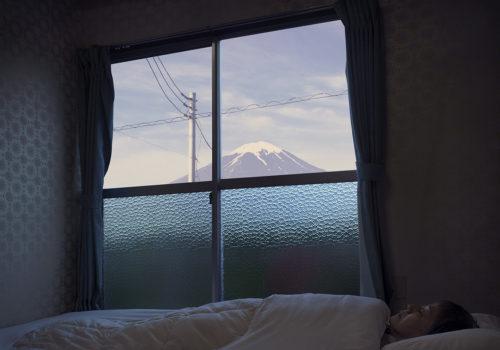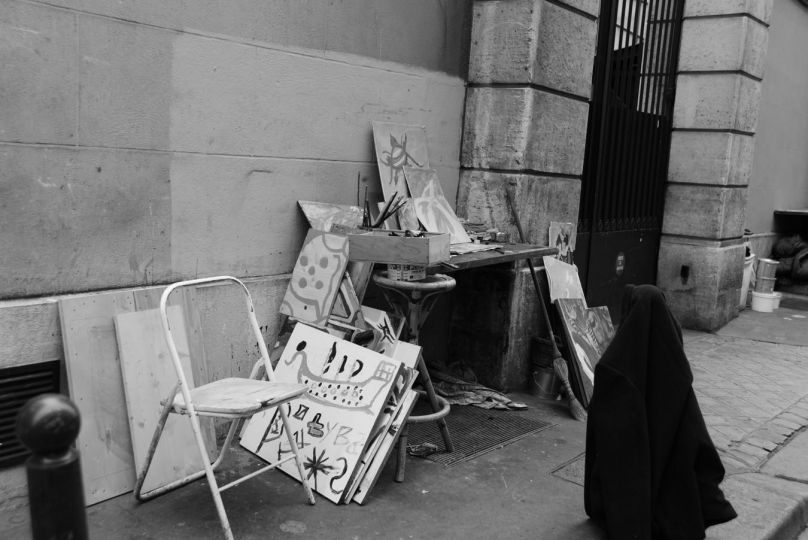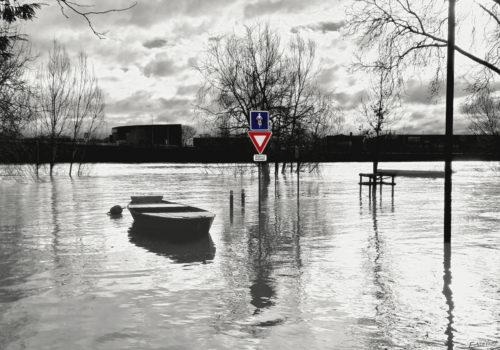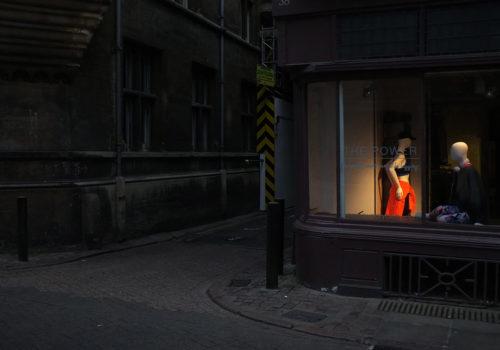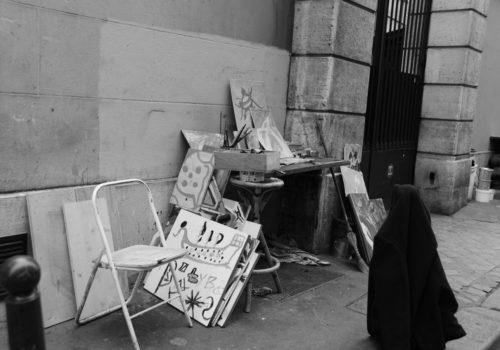Pierre-Elie de Pibrac : It’s all about perception.
An artistic heir to his grandfather, Paul de Cordon, Pierre Elie de Pibrac‘s first photo reportages date back to 2007. Although he only picks up his camera to tell a story, his work was soon rewarded with numerous prizes, including Paris Match, Orange and SFR, which allowed him to join the “Vu photo agency”.
What’s special about his work is that he doesn’t confine himself to a single photographic genre, seeing several images in a single one. His reportages are the fruit of encounters and meticulous preparation. He immerses himself in the culture of his destination country long before his departure, setting up coincidences to enable him to be open to encounters and to all fields of possibility.
A great admirer of the work of Robert Doisneau, Saul Leiter and Jeff Wall, to name but a few, he has a perfect mastery of photography techniques.
Currently exhibited at the Musée Guimet, the images shown follow a photographic project initiated in 2016 in Cuba. Between December 2019 and August 2020, Pierre-Elie de Pibrac criss-crossed Japan to produce the Hakanai Sonzai series (“I feel I am an ephemeral creature”). In the course of this immersive investigation, the photographer met people seeking to express their personal singularity.
He rubbed shoulders with yakuza, Fukushima survivors and hikikomori or “evaporated” people who have opted for voluntary disappearance. For these images, the photographer drew inspiration from the Japanese tradition of Ukiyo-e, the subtle art of ink and woodcuts. These black-and-white photographs highlight a certain precariousness of existence… Not to be missed!
“Ephemeral Portrait of Japan”
Musée Guimet: www.guimet.fr
Until January 15, 2024
Website : www.pierreeliedepibrac.com
Instagram : depibrac
What was your first photographic trigger?
Pierre-Elie de Pibrac: New York. When I arrived in this city, I immediately wanted to capture its energy and make it my own.
The man or woman in the picture who inspires you?
Pierre-Elie de Pibrac: My grandfather, the photographer Paul de Cordon, was free, daring, cultured and curious. He had a very strong personality.
What image would you have liked to have made?
Pierre-Elie de Pibrac: There are many, but I’m glad I didn’t make them, because thanks to that I learned and was amazed.
Which one moved you the most?
Pierre-Elie de Pibrac: Kevin Carter’s photograph, Vulture stalking a starving little girl, Sudan, 1993. This photograph torments me for several reasons. The subject, the excruciating reality of the suffering of a thirsty little girl dragging herself along the ground to find a watering hole, closely followed by a vulture biding its time. Did the photographer photograph this scene without coming to the aid of this dying little girl? What would I have done in his place? This photograph alerted public opinion to the atrocity of the situation in Sudan, but was it the right thing to do? And finally, the photographer’s tragedy: after receiving the Pulitzer Prize for this photograph, Kevin Carter committed suicide because he couldn’t face the reality of the situation.
Which one made you angry?
Pierre-Elie de Pibrac: No photograph has ever made me angry.
A key image in your personal pantheon?
Pierre-Elie de Pibrac : The photograph of dancers Laura Bachman, Marion Barbeau, Léonore Baulac, Cyril Chokroun, Juliette Hilaire, Emma d’Humières, Axel Ibot, Germain Louvet and Hugo Marchand on the roofs of the Paris Opéra taken on the day my eldest daughter, Alma, was born. That day my life was changed it was the day of the birth of my daughter, and that photo changed my career as a photographer.
The image that obsesses you?
Pierre-Elie de Pibrac: The one I haven’t made yet.
With no budget limit, what would you dream of acquiring?
Pierre-Elie de Pibrac: A work by Valérie Belin.
In your opinion, what’s the quality needed to be a good photographer?
Pierre-Elie de Pibrac: You need to be versatile, with a mix of curiosity, empathy, patience and culture.
What, if any, is the secret to the perfect image?
Pierre-Elie de Pibrac: The perfect image is the one that the photographer feels in his gut to be perfect.
Who would you like to photograph?
Pierre-Elie de Pibrac: Anyone with whom I want to share a story.
A must-have photo book?
Pierre-Elie de Pibrac: I must admit that I have an acute collectionnitis of photographic books. The one I’m sure will never leave me is Instants de Cirque, by my grandfather, Paul de Cordon, published in 1977 by Editions du Chêne. I’ve studied it from every angle, and I look at it at least once a week!
Your childhood camera?
Pierre-Elie de Pibrac: I didn’t take any photographs until I was 23!
The one you use today ?
Pierre-Elie de Pibrac: A Linhof Techno view camera.
What’s your favorite drug?
Pierre-Elie de Pibrac: My wife and my three children.
What’s the best way for you to disconnect?
Pierre-Elie de Pibrac : L’ile d’Yeu, and what’s more, the reception’s really bad there!
What is your relationship with images?
Pierre-Elie de Pibrac: Pretty good!
Your greatest quality?
Pierre-Elie de Pibrac: Perseverance, I think. I never give up. I always believe.
Your latest folly?
Pierre-Elie de Pibrac: starting to Wing Foil on a cold, rough sea – my body’s still suffering from it!
An image to illustrate a new banknote?
Pierre-Elie de Pibrac : Portraits of great artists who left their mark on their time.
The job you wouldn’t have liked to do?
Pierre-Elie de Pibrac: None. I’m curious about everything, and I think everything is interesting. On the other hand, many jobs are extremely hard and often thankless, but essential. I’m very lucky to have a job that’s a passion.
Your greatest professional extravagance?
Pierre-Elie de Pibrac: Taking my children with me on all my projects. In Japan, we drove over 26,000 km together to make Hakanai Sonzai.
What are the differences between photography and art photography?
Pierre-Elie de Pibrac: In my approach to photography, history and culture play a fundamental role. I believe that an art photograph is one that seeks to reflect on its time, to bear subjective witness. A photograph can be an image, whereas an art photograph seeks to go beyond the image.
What city, country or culture do you dream of discovering?
Pierre-Elie de Pibrac : The world, everything I don’t know makes me want to be discovered. Every city, every culture, every country is worth seeing.
The place you never get tired of?
Pierre-Elie de Pibrac: My bed.
Your biggest regret?
Pierre-Elie de Pibrac: I don’t have any. I’ve always seen failure as an opportunity, because only those who dare fail.
In terms of social networks, are you more into Instagram, Facebook, Tik Tok or Snapchat, and why?
Pierre-Elie de Pibrac: I’m not into social networking at all. I try to be present at important professional moments, but in general, I avoid social networks.
Color or B&W?
Pierre-Elie de Pibrac: Both, they’re two complementary ways of telling a story that I like.
Daylight or artificial light?
Pierre-Elie de Pibrac : Daylight, always.
In your opinion, which is the most photogenic city?
Pierre-Elie de Pibrac: All cities, as long as you know how to look at them.
If God existed, would you ask him to pose for you, or would you opt for a selfie with him?
Pierre-Elie de Pibrac: For me, God exists. The day I meet him, I’ll have a lot more on my mind than a selfie!
If I could organize your ideal dinner party, who would be at the table?
Pierre-Elie de Pibrac: I love that question, it makes me dream! I’d organize a huge cosmopolitan dinner with Nelson Mandela, Louis de Funes, Benoit XVI, Simone Veil, Quentin Tarantino, Sylvain Tesson, Marie Curie, Mother Teresa, Albert Einstein, Angela Davis, Paul de Cordon, Albert Camus, Jim Morrison, Steve McQueen, Ayrton Senna, Elizabeth II, Leonard de Vinci and of course my wife!
Which image represents the current state of the world for you?
Pierre-Elie de Pibrac: Sandro Botticelli’s Circles of Hell. The world is walking on its head with the development of ultra-individualism and permanent inquisition.
What’s missing in today’s world?
Pierre-Elie de Pibrac: Generally speaking, more honesty and patience and less social networking!
If you had to do it all over again?
Pierre-Elie de Pibrac: I’d do it all over again.
What’s your final word?
Pierre-Elie de Pibrac: Matane (which means “see you next time” in Japanese).

